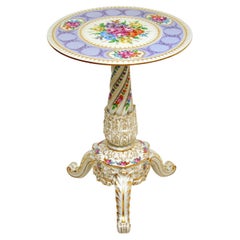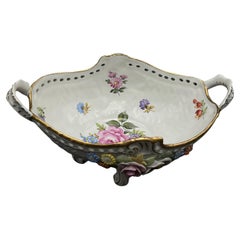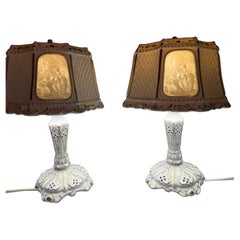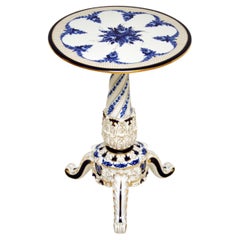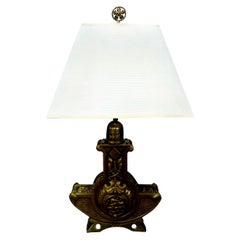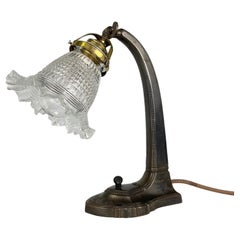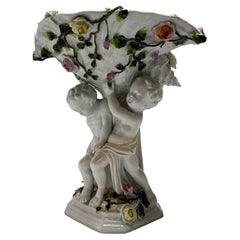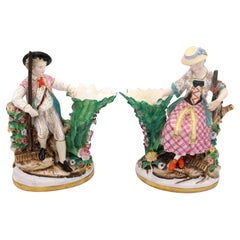Von Schierholz Porcelain Furniture
to
1
4
4
2
2
1
1
1
Antique Dresden Style Porcelain Side Table
By Von Schierholz Porcelain
Located in London, GB
A stunning antique Dresden style porcelain occasional table. This was made in Germany by Von Schierholz, it dates from around the 1950’s.
The quality is outstanding, this is beautif...
Category
1950s German Vintage Von Schierholz Porcelain Furniture
Materials
Porcelain
Rococo style Jardinière with hand-painted floral pattern from PMP Germany
By Von Schierholz Porcelain
Located in Skien, NO
Richly decorated Rococo style high quality German porcelain Jardinière with hand-painted floral pattern from PMP 1817 GDR Germany.
Handpainted porcelain, artist signed under. Gold ...
Category
Late 20th Century German Rococo Von Schierholz Porcelain Furniture
Materials
Porcelain
Art Nouveau While Lithophane Porcelain Two Lamps Schierholz PMP 1970
By Von Schierholz Porcelain
Located in Uppsala , SE
2 Elegant Lithophane Porcelain lamps, Schierholz, PMP, Plaue, late 20th century,
A lithophane is a thin plaque of translucent material, normally porcelain, which has been moulded to ...
Category
1970s German Vintage Von Schierholz Porcelain Furniture
Materials
Porcelain
Antique Dresden Style Porcelain Occasional Table
By Von Schierholz Porcelain
Located in London, GB
A stunning antique Dresden style porcelain occasional table. This was made in Germany by Von Schierholz, it dates from around the 1960’s.
The quality is outstanding, this is beautif...
Category
1960s German Vintage Von Schierholz Porcelain Furniture
Materials
Porcelain
Related Items
Austrian Art Nouveau Bronze Lamp
Located in Houston, TX
Lovely period Austrian Art Nouveau bronze table lamp. This beautifully detailed, high quality Austrian bronze lamp has been newly wired and would w...
Category
1910s Austrian Art Nouveau Vintage Von Schierholz Porcelain Furniture
Materials
Bronze
Art Nouveau Table Lamp, 1910's
Located in Praha, CZ
Beautiful antique Art Nouveau lamp made of copper alloy, patinated to old bronze. Produced in former Czechoslovakia in the very beginning of 2...
Category
Early 20th Century Czech Art Nouveau Von Schierholz Porcelain Furniture
Materials
Metal
Mid-19th Century French Hand Painted Faience Jardinière from Rouen
By Rouen
Located in Dallas, TX
Decorate a dining room table or a mantel with this large antique jardinière; crafted in Normandy, circa 1860, the oblong planter stands on scrolled feet...
Category
Mid-19th Century French Louis XV Antique Von Schierholz Porcelain Furniture
Materials
Ceramic, Faience
19th Century French Painted Ceramic Barbotine Jardinière with Floral Decor
Located in Dallas, TX
This elegant colorful hand painted Majolica planter was sculpted in Montigny sur Loing, France, circa 1860. The ceramic jardinière with root shape handles features high relief soft pink, blue and beige rose flowers with pale green leaves, and brown and grey background. The ceramic vase is in good condition commensurate with age and use (minor chips on few petals).
Impressionist ceramics term generally applies to "paint the slip" or "batch gouache". At the turn of the nineteenth and twentieth centuries, the towns of Montigny-sur-Loing and Marlotte are many artists living places like Jean-Baptiste Corot, Eugène Thirion (1839-1910), Adrien Schulz (1851-1931), Numa Gillet (1868-1940) and Lucien Cahen-Michel (1888-1980), all attracted by the quality of the landscape and the light. When Eugene Schopin founded in 1872 a ceramics factory, he worked with the painters to create a range of designs inspired by Impressionism and decorated according to new public demands. Several ceramic factories will develop around this Impressionist movement. The most famous, such as Georges Delvaux (1834-1909), Albert Boué (1862-1918) and Charles Alphonse Petit (1862-1927), will produce until 1922. Other manufacturers, such as Theodore Lefront...
Category
Late 19th Century French Antique Von Schierholz Porcelain Furniture
Materials
Ceramic, Majolica
$900
H 7.5 in W 12.5 in D 10 in
Art Nouveau lamp circa 1910
Located in NANTES, FR
Beautiful Art Nouveau lamp, circa 1910.
Brown-veined alabaster shell.
The base is bronze with floral decoration.
Electric and in perfect condition.
Total Height: 52 cm
Shell Diamete...
Category
1910s French Art Nouveau Vintage Von Schierholz Porcelain Furniture
Materials
Alabaster, Bronze
Large Antique Moroccan Arabesque Style Octagonal Inlaid Table
Located in Houston, TX
Large antique Moroccan Arabesque style octagonal inlaid table.
This stunning Moroccan octagon shaped table is inlaid with various woods, bone a...
Category
1920s Moroccan Islamic Vintage Von Schierholz Porcelain Furniture
Materials
Bone, Mother-of-Pearl, Wood
Majorelle Art Nouveau Lamp
By Atelier Majorelle
Located in NANTES, FR
Majorelle Art Nouveau lamp
Large lamp around 1900 foot in gilded bronze and lampshade in alabaster.
Very good quality of bronze and pretty floral m...
Category
Early 20th Century French Art Nouveau Von Schierholz Porcelain Furniture
Materials
Alabaster, Bronze
Andrianna Shamaris Mid Century Style Teak Wood Side Table
By Andrianna Shamaris
Located in New York, NY
Single slab reclaimed teak wood side table with a natural oil finish revealing the beautiful grain in the wood. Floating on mid century style legs.
Own an Andrianna Shamaris origi...
Category
2010s Mid-Century Modern Von Schierholz Porcelain Furniture
Materials
Wood, Teak, Reclaimed Wood
Modernist Rectilinear Translucent Lucite Occasional/ Side Table
Located in New York, NY
This sophisticated modernist side/ occasional table was realized in the United States during the latter half of the 20th century. It features a rectilinear and graphic body composed of beautiful translucent lucite...
Category
20th Century American Modern Von Schierholz Porcelain Furniture
Materials
Lucite
Art Nouveau Desk Lamp
Located in NANTES, FR
Desk lamp in gilded spelter circa 1910. Tulip tilt adjustment possible.
Tulip in opalescent glass.
Electrified, B22 socket.
in perfect condition.
Height: 34 cm
Width: 25 cm
Depth: 1...
Category
Early 20th Century French Art Nouveau Von Schierholz Porcelain Furniture
Materials
Spelter
Daum Nancy Art Nouveau Lamp
By Daum
Located in NANTES, FR
Daum Nancy Art Nouveau table lamp, circa 1910.
High-quality wrought iron base, stamped (illegible).
Powder tulip signed Daum Nancy.
Electric and in perfect condition.
Height: 40.5 c...
Category
1910s French Art Nouveau Vintage Von Schierholz Porcelain Furniture
Materials
Wrought Iron
Quezal Art Nouveau Lamp
By Quezal
Located in NANTES, FR
Art nouveau lamp circa 1910.
Brass and copper base.
Iridescent glass tulip signed Quezal.
In perfect condition and electrified.
Total height: 38.5 cm
Base diameter: 15.5 cm
Width: 30 cm
Quezal Art Glass
Quezal Art Glass – The Journal of Antiques and Collectibles – April 2003
By Malcolm Mac Neil
Some of the most beautiful and alluring art glass made in America during the early part of the 20th Century was made by the Quezal Art Glass and Decorating Company. Often in the shape of blossoming lilies with brilliant gold interiors and colorfully decorated with floral and other motifs inspired by nature, Quezal art glass ranks right alongside the iridescent glass of Louis Comfort Tiffany and Frederick Carder. Quezal artisans created an extensive range of decorative and useful items, including vases, compotes, finger bowls, open salts, candle holders, and shades for lighting fixtures, which are equivalent in terms of beauty and quality of craftsmanship to Tiffany’s Favrile and Carder’s Aurene glass. In recent years, glass collectors have discovered anew the special charms and appeal of Quezal art glass, and collector desirability for this lovely glassware has increased dramatically.
The Quezal Art Glass and Decorating Company was incorporated a century ago, on March 27, 1902. It was founded by Martin Bach, Sr., Thomas Johnson, Nicholas Bach, Lena Scholtz, and Adolph Demuth. The factory was located on the corner of Fresh Pond Road and Metropolitan Avenue in Maspeth, Queens, New York. In October 1902, the trademark “Quezal” was successfully registered. By 1904, roughly fifty glassworkers were employed at the works.
Martin Bach, Sr. was the president, proprietor, and guiding force behind this successful company. Born in 1862 in Alsace-Lorraine to German parents, he emigrated to the United States in 1891. Before his emigration, Bach worked in Saint-Louis, France, at the Saint-Louis Glass Factory. After Bach arrived in this country, he was hired by Louis C. Tiffany as the latter’s first batch-mixer or chemist at the newly established Tiffany Glass and Decorating Company, in Corona, Queens. After a period of about eight years, Bach left Tiffany and established his own glassworks. By this time, Bach had already started his small family. He and his German-born wife, Anne-Marie Geisser, whom he married in the fall of 1889, in Paris, France, had three children. Two daughters, Jennie and Louise, were born in France and a son, Martin, Jr., was born in Corona.
Bach was assisted by Thomas Johnson, an English immigrant, and Maurice Kelly, a native of Corona, both of whom were gaffers or master glassblowers. Johnson and Kelly helped pave the way for Quezal’s early accomplishments and later recognition. Thomas Johnson, like Bach, was a founding member and also previously employed by Louis C. Tiffany. Johnson’s association with Quezal, however, was relatively short lived. Around 1907, Johnson left for Somerville, Massachusetts, where he became involved in making Kew Blas glass, under William S. Blake at the Union Glass Company. Maurice Kelly’s tenure with Quezal was also brief. Kelly worked at Quezal from January 1902 until July 1904, but by November 1904, he was making Favrile glass at Tiffany Furnaces, where he would happily remain until 1918.
To this day, the belief still exists that there once existed a man named Quezal, who worked for Louis C. Tiffany, and it is after him that Quezal glass is named. In truth, however, the founders of the Quezal Art Glass and Decorating Company named the company and its products after one of the world’s most beautiful birds, the elusive and rare quetzal, which dwells in the treetops of the remote tropical forests of Central America. A rare company promotional brochure provides a vivid description of the quetzal: Of all the birds of the America’s, it is the most gorgeous. No more splendid sight is to be seen in all the world than a quezal, flying like a darting flame through the depths of a Central American forest. Its back is of a brilliant metallic green, so vivid it shines even in the twilight of the woods like a great emerald and its breast is a crimson so deep and bright that every motion of the wonderful creature is a flashing of rubies among the trees and giant creepers. It bears a true golden crown upon its head – a helmet of bright yellow and green, shaped just as the helmet of old Aztec kings were shaped. Its tail is composed of lacelike plumes, extending more than two and one-half feet beyond its body.
The quezal was certainly an appropriate designation for the company’s resplendent glassware. One of the most prized characteristics of Quezal art glass is the shimmering and dazzling brilliance reflected in the iridescent surfaces on the interior as well as exterior of the glass. The radiant rainbow colors in metallic hues, including gold, purple, blue, green, and pink, to name only a few, were certainly inspired by the quetzal and its feathers. Not surprisingly, lustrous feathers, in shades of opal, gold, emerald, and blue, are among the most common decorative motifs encountered on Quezal glass.
The enduring hallmark of Quezal art glass is its unique expression of the Art Nouveau style, based on organic shapes and naturalistic motifs coupled with technical perfection in the execution. Vases, compotes, drinking vessels, and shades for lighting fixtures were often fashioned to resemble flowers such as crocuses, tulips, calla lilies, casablanca lilies, and jack-in-the-pulpits. Variously colored inlaid threads of glass, pulled and twisted by hooks, simulate naturalistic floral and leaf patterns, lily pads, clover leafs, and vines. Opal, gold, and green colors prevail and the glass is generally opaque. Red is the rarest color of all. Compared with Tiffany’s Favrile glass, the crisp, vivid, and colorful decoration of Quezal art glass is distinctively precise, symmetrical, and restrained.
Other Quezal wares recall shapes and styles favored in ancient Egypt, Persia, Greece, and Rome, as well as the Italian Renaissance and the Georgian period in England. This is especially true of classic-shaped vases and bowls of translucent amber glass, which have a single surface color such as iridescent gold or blue. Still, others were inspired by traditional Chinese and Japanese forms.
The Gorham Manufacturing Company in Providence, Rhode Island, and the Alvin Silver Manufacturing Company in Sag Harbor, Long Island, purchased Quezal art glass, which they in turn embellished in their shops with silver overlay decoration in the fashionable Art Nouveau style and later resold. Gorham’s silver overlay designs mostly include stylized floral motifs. Alvin’s silver designs are wonderfully organic. One sumptuous design is of a group of sinuous iris blossoms with carefully articulated petals surrounded by attenuated meandering vines. Collectors should note that not all silver-deposit pieces are marked with a maker’s mark since the silversmith had to be quite careful not to damage the glass underneath.
A rare 1907 retail catalog survives from Bailey, Banks, and Biddle Company, a luxury goods retailer in Philadelphia, which reveals original retail prices of Quezal art glass. A surprising revelation provided by this catalog is that Quezal art glass was nearly twice as expensive as comparable French imported glass made by such renowned firms as Gallé and Daum. Hock glasses, a stemmed glass used primarily for drinking German white wine, were sold by the dozen and retailed between $50 and $75. Fingerbowls were also sold by the dozen and retailed between $50 and $100. These high retail prices were nearly the same as those charged for Tiffany’s Favrile glass, and suggest Quezal art glass was also marketed towards the high-end or luxury market.
Electricity was a brand new invention in the late 1800s and American glass manufacturers developed novel approaches for concealing the electric light bulb, which was rather harsh to the eye and perhaps unflattering to the domestic interior. Tiffany, Steuben, and Quezal responded to this need with the most extraordinary and beautiful art-glass shades, all of which were hand-made and exquisitely fashioned. Many other companies also made art glass shades for table and floor lamps, electroliers, hallway fixtures, and wall sconces, but it was Quezal that excelled in this area and was the most prolific.
Quezal art glass shades were available in an infinite variety of shapes, sizes, colors, and decorations. Some shades are formed and decorated as lilies while others are bell-shaped and have ribbed or textured decoration. Rims are usually plain but sometimes are notched or ruffled. Common motifs include feather or hooked feather, leaf and vine, applied flowers, drape, fishnet, King Tut, and spider webbing. The workmanship shown on most Quezal shades...
Category
1910s French Art Nouveau Vintage Von Schierholz Porcelain Furniture
Materials
Brass, Copper
Previously Available Items
Rococo Antique Germany Plau Schierholz Porcelain figurine central piece
By Von Schierholz Porcelain
Located in Uppsala , SE
Antique late XIX Century German porcelain cherub centerpiece. From the Von Schierholz manufacture, Beautifully detailed porcelain figurine with floral accents and two cherubs. They hold a big shell richly decorated with flowers and leaves.
A stunning Rococo style.
Von Schierholz Plaue...
Category
Late 19th Century German Rococo Antique Von Schierholz Porcelain Furniture
Materials
Porcelain
H 9.45 in W 7.49 in D 9.45 in
Pair of Gardener Figure Porcelain Spill Vases by Schierholz, circa 1890
By Von Schierholz Porcelain
Located in Chapel Hill, NC
Circa 1890 pair of gardener figure porcelain spill vases by Schierholz factory, German. 1865-1907 marks. Each seated on wooden "log" with flowers flowing up the tree stumps they each...
Category
1890s German Antique Von Schierholz Porcelain Furniture
Materials
Porcelain
Vintage Porcelain Vase by Schierholz Porcelain, 1980s
By Von Schierholz Porcelain
Located in Bastogne, BE
Hand-painted vintage porcelain vase with boy figurines by Von Schierholz Porzellan Manufaktur Plaue G.m.b.H.
Germany. 1980s.
In excellent...
Category
1980s German Vintage Von Schierholz Porcelain Furniture
Materials
Porcelain
Antique German Schierholz Hand Painted & Gilt Figural Porcelain Compote, c1900
By Von Schierholz Porcelain
Located in Big Flats, NY
An antique German Schierholz figural compote offers hand painted and gilt porcelain construction with pierced lattice basket form bowl over apple tree form base with children, applie...
Category
Early 20th Century German Von Schierholz Porcelain Furniture
Materials
Porcelain
German Porcelain Six-Light Floral Decorated Chandelier
By Von Schierholz Porcelain
Located in San Francisco, CA
Von Schierholz Handmalerei painted and highly decorated floral pattern porcelain six-light chandelier with 22" gilt metal chain and canopy. Each arm with a floral pendant.
Made in G...
Category
20th Century German Baroque Von Schierholz Porcelain Furniture
Materials
Porcelain
Porcelain Centerpiece, Von Schierholz, Germany, 19th Century
By Von Schierholz Porcelain
Located in Madrid, ES
Centerpiece with four little angels or cupids holding on their backs a tray with a golden border and shaped like a flower and that has been enhanced with a multitude of delicate flow...
Category
19th Century German Neoclassical Antique Von Schierholz Porcelain Furniture
Materials
Porcelain
Antique Pr German Schierholz Porcelain Hand Painted Figural Compotes
By Von Schierholz Porcelain
Located in Big Flats, NY
Antique pair of German Von Schierholz hand-painted porcelain figural compotes with young girl and boy on seesaw, stamped with green crown and shield mark o...
Category
Late 19th Century German Antique Von Schierholz Porcelain Furniture
Materials
Porcelain
Von Schierholz Porcelain furniture for sale on 1stDibs.
Von Schierholz porcelain furniture are available for sale on 1stDibs. These distinctive items are frequently made of porcelain and are designed with extraordinary care. There are many options to choose from in our collection of Von Schierholz Porcelain furniture, although gray editions of this piece are particularly popular. Many of the original furniture by Von Schierholz Porcelain were created in the mid-century modern style in germany during the 20th century. If you’re looking for additional options, many customers also consider furniture by Opal Kleinmöbel, Friedrich Wilhelm Möller, and Hans Gunther Reinstein. Prices for Von Schierholz Porcelain furniture can differ depending upon size, time period and other attributes — on 1stDibs, these items begin at $56 and can go as high as $2,357, while a piece like these, on average, fetch $1,291.
